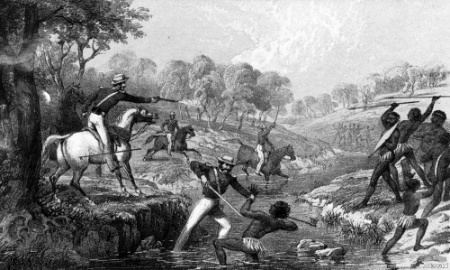Start date January 1838 | ||
 | ||
Waterloo creek massacre
The Waterloo Creek Massacre or Slaughterhouse Creek massacre refers to a clash between mounted police and indigenous Australians in January 1838. The events have been subject to much dispute due to conflicting accounts of what took place and specifically the number of fatalities. The interpretation of events at Waterloo Creek became part of the ongoing public debate in Australia during the late 1990s known as the history wars.
Contents
- Waterloo creek massacre
- The events
- Statements from eyewitnesses
- Differing views from historians
- References
The events
A Sydney mounted police detachment was despatched by acting Lieutenant Governor of New South Wales Colonel Kenneth Snodgrass, to track down the Namoi, Weraerai and Kamilaroi people who had killed five stockmen in separate incidents on recently established pastoral runs on the upper Gwydir River area of New South Wales. After two months the mounted police, consisting of two sergeants and twenty troopers led by Major James Nunn, arrested 15 Aborigines along the Namoi River. They released all but two, one of whom was shot whilst attempting to escape. The main body of Kamilaroi eluded the troopers, thus Major Nunn’s party along with two stockmen pursued the Kamilaroi for three weeks from present-day Manilla on the Namoi River north to the upper Gwydir River. On the morning of January 26 in a surprise attack on Nunn’s party Corporal Hannan was wounded in the leg with a spear and subsequently four or five Aborigines were shot dead in retaliation. The Aborigines fled down the river as the troopers regrouped, rearmed and pursued them led by the second in command Lieutenant George Cobban. Cobban's party found their quarry about a mile down the river now known as Waterloo Creek, where a second engagement took place. The encounter lasted several hours, and no Aborigines were captured. It is this second clash where details of its occurrence contrast substantially.
There was an inquiry held on 22 July 1839 at the Merton Court house (New South Wales). There were no convictions and the matter was dropped. The only eyewitness accounts of this second engagement were provided to the judicial inquiry by Lieutenant Cobban and Sergeant John Lee.
Statements from eyewitnesses
Lieutenant Cobban claims he rode to the rear of the group and found a large cache of Aboriginal weapons in the bush and secured them. When he returned to the river, he admitted to seeing two Aborigines being shot, trying to escape and believed that at most three or four Aborigines had been killed in the conflict.
Sergeant John Lee was with the main detachment of mounted police that pursued the Aborigines into the river. He claims that forty to fifty Aborigines were badly killed.
Differing views from historians
In more recent times historians have differed on the site of the collision and the number of casualties.
Historian RHW Reece concluded that the site was at the junction of the Slaughterhouse Creek and the Gwydir River, and that sixty or seventy Aborigines had been killed.
Military historian Peter Stanley claims at least fifty Aborigines were killed.
Historian Lyndall Ryan considered that Sergeant Lee's estimate of 40 to 50 killed was the most reliable.
Historian Keith Windschuttle contends that what occurred at Waterloo Creek was a legitimate police action in which at most three to four Aborigines were killed in the second encounter.
